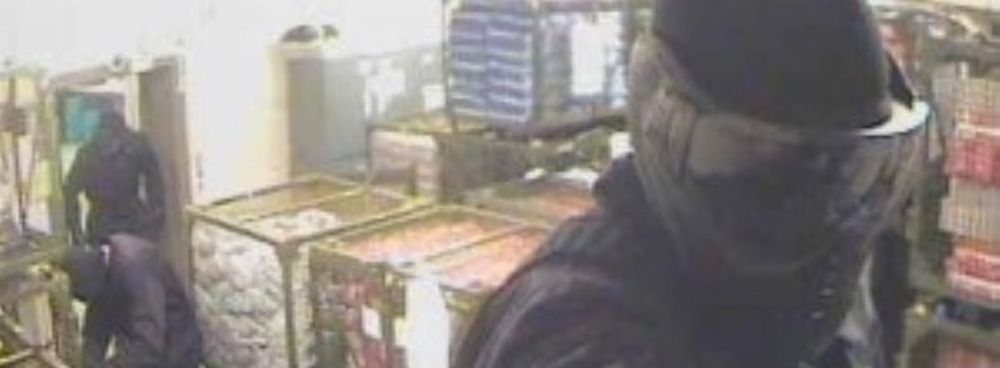Today in history
+4
nordic
Admin
Lolly
ramiejamie
8 posters
Page 24 of 40
Page 24 of 40 •  1 ... 13 ... 23, 24, 25 ... 32 ... 40
1 ... 13 ... 23, 24, 25 ... 32 ... 40 
 Re: Today in history
Re: Today in history
10 th February 1840
A Royal wedding :
Queen Victoria of the United Kingdom marries Prince Albert of Saxe-Coburg-Gotha.
Prince Albert and Queen Victoria married, on this day [10th February] 1840. Queen Victoria, unwittingly at the time, initiated the now worldwide trend of wearing a white wedding dress when she turned up in one on her wedding day. Prior to Queen Victoria’s wedding, any colour was used for brides’ wedding gowns and black was actually favoured by many.
Prince Albert and Queen Victoria remained madly in love and happily married until Prince Albert’s death in 1861. Queen Victoria insisted his clothes be laid out every day for the rest of her life and that nothing was to be disturbed in his apartments.

Victoria once complained to her Prime Minister, Lord Melbourne, that her mother’s close proximity promised “torment for many years”, Melbourne sympathized but said it could be avoided by marriage, which Victoria called a “schocking alternative”. Although a marriage between Victoria and her cousin Prince Albert had been encouraged by the Coburg family, specifically King Leopold I of the Belgians since 1936, Victoria was ambivalent at best toward the arrangement. She did however, show interest in Albert’s education for the future role he would have to play as her husband, but she resisted attempts to rush her into wedlock. King William IV of the United Kingdom preferred that Victoria marry her paternal first cousin, Prince George of Cambridge .

Just before the marriage, Albert was naturalized by Act of Parliament and granted the style of Royal Highness by an Order in Council. This style was only legal in Britain and under the German system of styles and titles Prince Albert remained His Serene Highness. Lord Melbourne advised against the Queen’s strong desire to grant her husband the title of “King Consort”. Parliament even refused to make Prince Albert a peer of the realm—(granting him a title of nobility) partly because of anti-German sentiment and a desire to exclude Albert from any political role .
https://en.m.wikipedia.org/wiki/Wedding_of_Queen_Victoria_and_Prince_Albert_of_Saxe-Coburg_and_Gotha
A Royal wedding :
Queen Victoria of the United Kingdom marries Prince Albert of Saxe-Coburg-Gotha.
Prince Albert and Queen Victoria married, on this day [10th February] 1840. Queen Victoria, unwittingly at the time, initiated the now worldwide trend of wearing a white wedding dress when she turned up in one on her wedding day. Prior to Queen Victoria’s wedding, any colour was used for brides’ wedding gowns and black was actually favoured by many.
Prince Albert and Queen Victoria remained madly in love and happily married until Prince Albert’s death in 1861. Queen Victoria insisted his clothes be laid out every day for the rest of her life and that nothing was to be disturbed in his apartments.

Victoria once complained to her Prime Minister, Lord Melbourne, that her mother’s close proximity promised “torment for many years”, Melbourne sympathized but said it could be avoided by marriage, which Victoria called a “schocking alternative”. Although a marriage between Victoria and her cousin Prince Albert had been encouraged by the Coburg family, specifically King Leopold I of the Belgians since 1936, Victoria was ambivalent at best toward the arrangement. She did however, show interest in Albert’s education for the future role he would have to play as her husband, but she resisted attempts to rush her into wedlock. King William IV of the United Kingdom preferred that Victoria marry her paternal first cousin, Prince George of Cambridge .

Just before the marriage, Albert was naturalized by Act of Parliament and granted the style of Royal Highness by an Order in Council. This style was only legal in Britain and under the German system of styles and titles Prince Albert remained His Serene Highness. Lord Melbourne advised against the Queen’s strong desire to grant her husband the title of “King Consort”. Parliament even refused to make Prince Albert a peer of the realm—(granting him a title of nobility) partly because of anti-German sentiment and a desire to exclude Albert from any political role .
https://en.m.wikipedia.org/wiki/Wedding_of_Queen_Victoria_and_Prince_Albert_of_Saxe-Coburg_and_Gotha

gassey- BronzeProudly made in Wigan bronze award
- Posts : 4669
Join date : 2019-08-21
Age : 71
Location : Pemberton
 Re: Today in history
Re: Today in history
11 th February 1990
Nelson Mandela is released from prison :
Nelson Mandela is released from Victor Verster Prison outside Cape Town, South Africa after 27 years as a political prisoner .
Nelson Mandela, leader of the South African movement to end apartheid, was released from prison on February 11th, 1990 -- 27 years after he was put behind bars.
After marching through the streets, he spoke at Cape Town's City Hall before thousands.
"I greet you all in the name of peace, democracy and freedom for all," Mandela said.

"After 27 years, his head high and his fist clenched, Nelson Mandela walked out of Victor Verster Prison like a chief of state flanked by his First Lady, and by the men who'd been hired to protect him," Simon reported.
The South African State Police provided security for Mandela, once the most wanted man in Africa, as he marched and waved to the thousands lining the streets.
"The government insisted it would release Mandela into dignity, but by giving his organization less than 24 hours notice, it created conditions for chaos," explained Simon.
"Police moved in to restore order and opened fire on the people, indiscriminately and often. People replied by hurling bottles. Police opened fire again," Simon continued.
At least two people were reported dead and hundreds more were injured on that day. It wasn't until Mandela appeared on the steps of City Hall to address his supporters that the violence stopped.
Mandela became deputy national president of the ANC in 1952. He advocated for a peaceful movement against South Africa's institutionalized segregation and white supremacy, also known as apartheid.

https://www.npr.org/sections/parallels/2013/06/11/190671704/the-day-nelson-mandela-walked-out-of-prison?t=1613029450442
Nelson Mandela is released from prison :
Nelson Mandela is released from Victor Verster Prison outside Cape Town, South Africa after 27 years as a political prisoner .
Nelson Mandela, leader of the South African movement to end apartheid, was released from prison on February 11th, 1990 -- 27 years after he was put behind bars.
After marching through the streets, he spoke at Cape Town's City Hall before thousands.
"I greet you all in the name of peace, democracy and freedom for all," Mandela said.

"After 27 years, his head high and his fist clenched, Nelson Mandela walked out of Victor Verster Prison like a chief of state flanked by his First Lady, and by the men who'd been hired to protect him," Simon reported.
The South African State Police provided security for Mandela, once the most wanted man in Africa, as he marched and waved to the thousands lining the streets.
"The government insisted it would release Mandela into dignity, but by giving his organization less than 24 hours notice, it created conditions for chaos," explained Simon.
"Police moved in to restore order and opened fire on the people, indiscriminately and often. People replied by hurling bottles. Police opened fire again," Simon continued.
At least two people were reported dead and hundreds more were injured on that day. It wasn't until Mandela appeared on the steps of City Hall to address his supporters that the violence stopped.
Mandela became deputy national president of the ANC in 1952. He advocated for a peaceful movement against South Africa's institutionalized segregation and white supremacy, also known as apartheid.
https://www.npr.org/sections/parallels/2013/06/11/190671704/the-day-nelson-mandela-walked-out-of-prison?t=1613029450442

gassey- BronzeProudly made in Wigan bronze award
- Posts : 4669
Join date : 2019-08-21
Age : 71
Location : Pemberton
 Re: Today in history
Re: Today in history
11 th February 1993
The abduction of James Bulger :
Two-year-old James Bulger is abducted from New Strand Shopping Centre by two ten-year-old boys, who later torture and murder him.
James Patrick Bulger (16 March 1990[1] – 12 February 1993) was a 2-year-old boy from Kirkby, Merseyside, England, who was abducted, tortured and killed by two 10-year-old boys, Robert Thompson and Jon Venables. Bulger was led away from the New Strand Shopping Centre in Bootle as his mother had taken her eyes off him momentarily. His mutilated body was found on a railway line 2.5 miles (4 km) away in Walton, Liverpool, two days after his abduction. Thompson and Venables were charged on 20 February 1993 with Bulger's abduction and murder.
Closed-circuit television (CCTV) surveillance from the New Strand Shopping Centre in Bootle taken on Friday, 12 February 1993, showed Thompson and Venables casually observing children, apparently selecting a target. The boys were playing truant from school, which they did regularly. Throughout the day, Thompson and Venables were seen stealing various items including sweets, a troll doll, some batteries and a can of blue paint, some of which were later found at the murder scene. One of the boys later revealed that they were planning to find a child to abduct, lead him to the busy road alongside the shopping centre, and push him into the path of oncoming traffic.


https://en.m.wikipedia.org/wiki/Murder_of_James_Bulger
The abduction of James Bulger :
Two-year-old James Bulger is abducted from New Strand Shopping Centre by two ten-year-old boys, who later torture and murder him.
James Patrick Bulger (16 March 1990[1] – 12 February 1993) was a 2-year-old boy from Kirkby, Merseyside, England, who was abducted, tortured and killed by two 10-year-old boys, Robert Thompson and Jon Venables. Bulger was led away from the New Strand Shopping Centre in Bootle as his mother had taken her eyes off him momentarily. His mutilated body was found on a railway line 2.5 miles (4 km) away in Walton, Liverpool, two days after his abduction. Thompson and Venables were charged on 20 February 1993 with Bulger's abduction and murder.
Closed-circuit television (CCTV) surveillance from the New Strand Shopping Centre in Bootle taken on Friday, 12 February 1993, showed Thompson and Venables casually observing children, apparently selecting a target. The boys were playing truant from school, which they did regularly. Throughout the day, Thompson and Venables were seen stealing various items including sweets, a troll doll, some batteries and a can of blue paint, some of which were later found at the murder scene. One of the boys later revealed that they were planning to find a child to abduct, lead him to the busy road alongside the shopping centre, and push him into the path of oncoming traffic.


https://en.m.wikipedia.org/wiki/Murder_of_James_Bulger

gassey- BronzeProudly made in Wigan bronze award
- Posts : 4669
Join date : 2019-08-21
Age : 71
Location : Pemberton
 Re: Today in history
Re: Today in history
13 th February 1692
The shameful massacre at Glen Coe :
Massacre of Glencoe: Almost 80 Macdonalds at Glen Coe, Scotland are killed early in the morning for not promptly pledging allegiance to the new king, William of Orange .
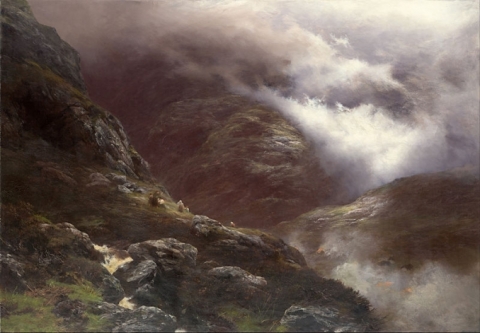
13 February 2018
 The River Coe flowing through Glen Coe | Image credit: :copyright: Neil Ritchie, editor
The River Coe flowing through Glen Coe | Image credit: :copyright: Neil Ritchie, editor
In the early hours of the 13th February 1692, 120 Scots Army soldiers of the Earl of Argyll’s Regiment of Foot, carry out the Massacre of Glencoe. The troops had been billeted with the MacDonalds of Glencoe since early February and were under the command of Captain Robert Campbell of Glenlyon. They carry out the orders that were written by Major Robert Duncanson of Argyll’s Regiment the day before:
“You are hereby ordered to fall upon the rebells, the McDonalds of Glenco, and put all to the sword under seventy. you are to have a speciall care that the old Fox and his sones doe upon no account escape your hands, you are to secure all the avenues that no man escape. This you are to putt in execution attfyve of the clock precisely; and by that time, or very shortly after it, I’ll strive to be att you with a stronger party: if I doe not come to you att fyve, you are not to tarry for me, but to fall on. This is by the Kings speciall command, for the good & safety of the Country, that these miscreants be cutt off root and branch. See that this be putt in execution without feud or favour, else you may expect to be dealt with as one not true to King nor Government, nor a man fitt to carry Commissione in the Kings service. Expecting you will not faill in the full-filling hereof, as you love your selfe, I subscribe these with my hand att Balicholis Feb: 12, 1692.
For their Majesties service”
The shameful atrocity of 13 February 1692 was not, as first believed, a clan feud between the Campbells and MacDonalds, it was in fact a government operation.
Events leading up to the massacre are important to understand the massacre itself.
King James VII of Scotland, and II of England, (a Stuart and a catholic) was deposed by Parliament in 1689, and William of Orange was installed as Monarch, which would lead to the massacre in 1692, and would later spark off the first of the *Jacobite Uprisings, in 1715 – the attempts to reinstate the Stuarts to the Throne.
https://en.m.wikipedia.org/wiki/Massacre_of_Glencoe
The shameful massacre at Glen Coe :
Massacre of Glencoe: Almost 80 Macdonalds at Glen Coe, Scotland are killed early in the morning for not promptly pledging allegiance to the new king, William of Orange .

13 February 2018
 The River Coe flowing through Glen Coe | Image credit: :copyright: Neil Ritchie, editor
The River Coe flowing through Glen Coe | Image credit: :copyright: Neil Ritchie, editorIn the early hours of the 13th February 1692, 120 Scots Army soldiers of the Earl of Argyll’s Regiment of Foot, carry out the Massacre of Glencoe. The troops had been billeted with the MacDonalds of Glencoe since early February and were under the command of Captain Robert Campbell of Glenlyon. They carry out the orders that were written by Major Robert Duncanson of Argyll’s Regiment the day before:
“You are hereby ordered to fall upon the rebells, the McDonalds of Glenco, and put all to the sword under seventy. you are to have a speciall care that the old Fox and his sones doe upon no account escape your hands, you are to secure all the avenues that no man escape. This you are to putt in execution attfyve of the clock precisely; and by that time, or very shortly after it, I’ll strive to be att you with a stronger party: if I doe not come to you att fyve, you are not to tarry for me, but to fall on. This is by the Kings speciall command, for the good & safety of the Country, that these miscreants be cutt off root and branch. See that this be putt in execution without feud or favour, else you may expect to be dealt with as one not true to King nor Government, nor a man fitt to carry Commissione in the Kings service. Expecting you will not faill in the full-filling hereof, as you love your selfe, I subscribe these with my hand att Balicholis Feb: 12, 1692.
For their Majesties service”
The shameful atrocity of 13 February 1692 was not, as first believed, a clan feud between the Campbells and MacDonalds, it was in fact a government operation.
Events leading up to the massacre are important to understand the massacre itself.
King James VII of Scotland, and II of England, (a Stuart and a catholic) was deposed by Parliament in 1689, and William of Orange was installed as Monarch, which would lead to the massacre in 1692, and would later spark off the first of the *Jacobite Uprisings, in 1715 – the attempts to reinstate the Stuarts to the Throne.
https://en.m.wikipedia.org/wiki/Massacre_of_Glencoe

gassey- BronzeProudly made in Wigan bronze award
- Posts : 4669
Join date : 2019-08-21
Age : 71
Location : Pemberton
 Re: Today in history
Re: Today in history
14 th February 1929
The St Valentines day massacre :
Saint Valentine's Day Massacre: Seven people, six of them gangster rivals of Al Capone's gang, are murdered in Chicago.
Chicago’s gang war reached its bloody climax in the so-called St. Valentine’s Day Massacre of 1929. One of Capone’s longtime enemies, the Irish gangster George “Bugs” Moran, ran his bootlegging operations out of a garage at 2122 North Clark Street. On February 14, seven members of Moran’s operation were gunned down while standing lined up, facing the wall of the garage. Some 70 rounds of ammunition were fired. When police officers from Chicago’s 36th District arrived, they found one gang member, Frank Gusenberg, barely alive. In the few minutes before he died, they pressed him to reveal what had happened, but Gusenberg wouldn’t talk.
Police could find only a few eyewitnesses, but eventually concluded that gunmen dressed as police officers had entered the garage and pretended to be arresting the men. Though Moran and others immediately blamed the massacre on Capone’s gang, the famous gangster himself claimed to have been at his home in Florida at the time. No one was ever brought to trial for the murders. It remains one of the biggest unsolved crimes in history.
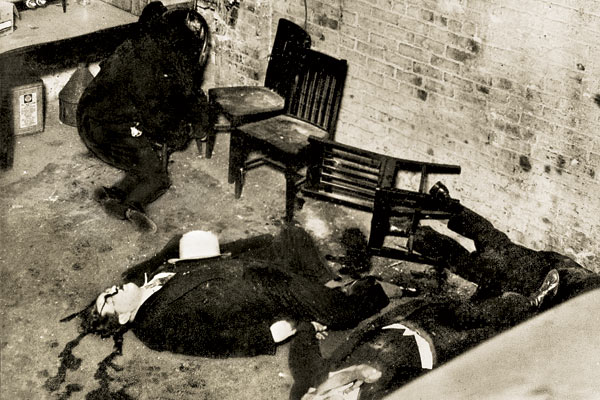
The grisly aftermath of the St. Valentine's Day Massacre
For all its impact, the full story of the St. Valentine’s Day Massacre has never been told, and most of the world still assumes that Capone orchestrated the attack. Yet new evidence suggests that the crime was almost certainly not the work of the man referred to within his own organization as the Big Fellow and known to the public as Scarface or Public Enemy Number One. Herbert Hoover almost certainly knew that, as did the men in Chicago assigned by the president to get Capone, and their refusal to acknowledge his innocence was one of many reasons the crime went unsolved.
As it happened, the explanation for the massacre may have been much simpler than anyone imagined. It may have been attributable to one of the oldest and surest motives of all: revenge.
But that wasn’t what the feds wanted to hear.
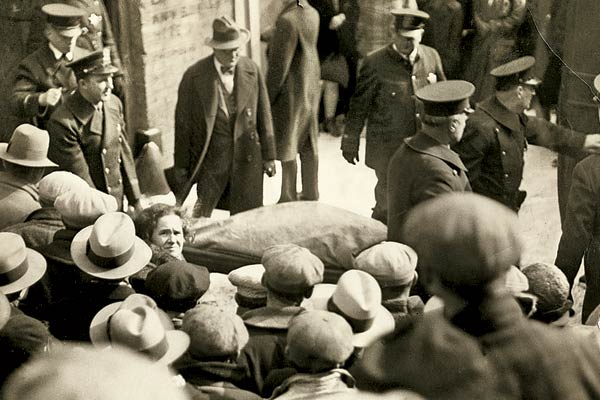 The day after the massacre, a coroner's jury watched police reenact the killings at the scene of the crime. For more photos, see the gallery
The day after the massacre, a coroner's jury watched police reenact the killings at the scene of the crime. For more photos, see the gallery
https://en.m.wikipedia.org/wiki/Saint_Valentine%27s_Day_Massacre
The St Valentines day massacre :
Saint Valentine's Day Massacre: Seven people, six of them gangster rivals of Al Capone's gang, are murdered in Chicago.
Chicago’s gang war reached its bloody climax in the so-called St. Valentine’s Day Massacre of 1929. One of Capone’s longtime enemies, the Irish gangster George “Bugs” Moran, ran his bootlegging operations out of a garage at 2122 North Clark Street. On February 14, seven members of Moran’s operation were gunned down while standing lined up, facing the wall of the garage. Some 70 rounds of ammunition were fired. When police officers from Chicago’s 36th District arrived, they found one gang member, Frank Gusenberg, barely alive. In the few minutes before he died, they pressed him to reveal what had happened, but Gusenberg wouldn’t talk.
Police could find only a few eyewitnesses, but eventually concluded that gunmen dressed as police officers had entered the garage and pretended to be arresting the men. Though Moran and others immediately blamed the massacre on Capone’s gang, the famous gangster himself claimed to have been at his home in Florida at the time. No one was ever brought to trial for the murders. It remains one of the biggest unsolved crimes in history.

The grisly aftermath of the St. Valentine's Day Massacre
For all its impact, the full story of the St. Valentine’s Day Massacre has never been told, and most of the world still assumes that Capone orchestrated the attack. Yet new evidence suggests that the crime was almost certainly not the work of the man referred to within his own organization as the Big Fellow and known to the public as Scarface or Public Enemy Number One. Herbert Hoover almost certainly knew that, as did the men in Chicago assigned by the president to get Capone, and their refusal to acknowledge his innocence was one of many reasons the crime went unsolved.
As it happened, the explanation for the massacre may have been much simpler than anyone imagined. It may have been attributable to one of the oldest and surest motives of all: revenge.
But that wasn’t what the feds wanted to hear.
 The day after the massacre, a coroner's jury watched police reenact the killings at the scene of the crime. For more photos, see the gallery
The day after the massacre, a coroner's jury watched police reenact the killings at the scene of the crime. For more photos, see the galleryhttps://en.m.wikipedia.org/wiki/Saint_Valentine%27s_Day_Massacre

gassey- BronzeProudly made in Wigan bronze award
- Posts : 4669
Join date : 2019-08-21
Age : 71
Location : Pemberton
 Re: Today in history
Re: Today in history
" It remains one of the biggest unsolved crimes in history."
I know who did it. Seriously.
My father lived in Chicago at that time in 1929. One day his friend, the photographer who took these photos showed him one of the photos. He told my dad that he had been told to be outside the garage with his camera at 10am tomorrow (14th). So just before 10am he was stood there in the freezing cold when he heard gunfire from inside the building. The gangsters came out and one said to him, "Right, you can go in , now".
My father asked him if could print a photo for him which he did and as I grew up in Norley the photo was floating around in drawer in our dining room. My mother promised to give me the photo when my father passed but it was taken by a relative, never to be seen again. I think I know who has it though. I did take a photo of the photo though and still have that.
So, the photograher knows who did the deed...!!
I know who did it. Seriously.
My father lived in Chicago at that time in 1929. One day his friend, the photographer who took these photos showed him one of the photos. He told my dad that he had been told to be outside the garage with his camera at 10am tomorrow (14th). So just before 10am he was stood there in the freezing cold when he heard gunfire from inside the building. The gangsters came out and one said to him, "Right, you can go in , now".
My father asked him if could print a photo for him which he did and as I grew up in Norley the photo was floating around in drawer in our dining room. My mother promised to give me the photo when my father passed but it was taken by a relative, never to be seen again. I think I know who has it though. I did take a photo of the photo though and still have that.
So, the photograher knows who did the deed...!!
gassey likes this post
 Re: Today in history
Re: Today in history
15 th February 1971
Decimal day " new coins please "
The decimalisation of British coinage is completed on Decimal Day .
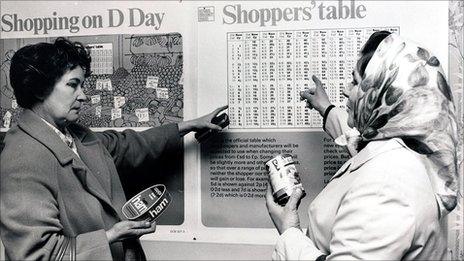
image captionShoppers had to learn how to use decimalised currency from 15 February 1971
Do you remember the tanner, shilling, florin and half crown?
If you do, you must be at least in your 40s, because it was back in February 1971, 50 years ago, that Britain "went decimal" and hundreds of years of everyday currency was turned into history overnight.
On 14 February that year, there were 12 pennies to the shilling and 20 shillings to the pound. The following day all that was history and the pound was made up of 100 new pence.
Decimalisation - having a currency based on simple multiples of 10 and 100 - had been a long time coming to Britain.
France and the United States had gone decimal in the 1790s. Britain first thought about doing the same in the 1820s but the idea did not gather momentum.
Prior to 1971, the closest Britain came to decimalisation was in 1849 with the introduction of the florin - a coin worth two shillings (24 old pence or 10 new pence) which was one-tenth of a pound.
During the 1960s a number of Commonwealth countries had gone decimal - Australia, New Zealand and South Africa.
"There was a sense in which there was a momentum behind this," said Dr Kevin Clancy, head of historical services at the Royal Mint. "It would have been a huge disruption, which was one of the reasons governments shied away from it."
"The old money in fact linked right the way back to ancient times," said Catherine Eagleton, curator of modern money at the British Museum.
"So it's the pound of silver divided into 240 pence. It was the historic way the Romans used their money and divided up the [librum, solidus and] denarius which was where the d in L.s.d. (or £sd) for pounds, shillings and pence comes from."

[size=10]Leaflets produced by the Decimal Currency Board alongside a 50p coin issued by the Royal Mint for the 50th anniversary of Decimal Day. Photograph: The Royal Mint/PA[/size]
Before and after D Day, shops carried posters with the prices in old and new money. On the day itself, these were switched, so the new prices were shown first. The new 1/2p, 1p and 2p coins came into circulation, to join those that had already been introduced.
The next day, the Guardian reported that generally things had gone smoothly: “The fear of confusion as travellers and shoppers met the new bronze coins for the first time proved unfounded.”
However, it said there was some “chicanery” as people realised the new 1p coin could be used to buy things that used to cost more than twice as much.
“Within an hour or so of its official introduction the coin was being used by quicker-thinking citizens to feed slot machines geared to the 6d piece.”
https://en.m.wikipedia.org/wiki/Decimal_Day
Decimal day " new coins please "
The decimalisation of British coinage is completed on Decimal Day .

image captionShoppers had to learn how to use decimalised currency from 15 February 1971
Do you remember the tanner, shilling, florin and half crown?
If you do, you must be at least in your 40s, because it was back in February 1971, 50 years ago, that Britain "went decimal" and hundreds of years of everyday currency was turned into history overnight.
On 14 February that year, there were 12 pennies to the shilling and 20 shillings to the pound. The following day all that was history and the pound was made up of 100 new pence.
Decimalisation - having a currency based on simple multiples of 10 and 100 - had been a long time coming to Britain.
France and the United States had gone decimal in the 1790s. Britain first thought about doing the same in the 1820s but the idea did not gather momentum.
Prior to 1971, the closest Britain came to decimalisation was in 1849 with the introduction of the florin - a coin worth two shillings (24 old pence or 10 new pence) which was one-tenth of a pound.
During the 1960s a number of Commonwealth countries had gone decimal - Australia, New Zealand and South Africa.
"There was a sense in which there was a momentum behind this," said Dr Kevin Clancy, head of historical services at the Royal Mint. "It would have been a huge disruption, which was one of the reasons governments shied away from it."
"The old money in fact linked right the way back to ancient times," said Catherine Eagleton, curator of modern money at the British Museum.
"So it's the pound of silver divided into 240 pence. It was the historic way the Romans used their money and divided up the [librum, solidus and] denarius which was where the d in L.s.d. (or £sd) for pounds, shillings and pence comes from."

[size=10]Leaflets produced by the Decimal Currency Board alongside a 50p coin issued by the Royal Mint for the 50th anniversary of Decimal Day. Photograph: The Royal Mint/PA[/size]
Before and after D Day, shops carried posters with the prices in old and new money. On the day itself, these were switched, so the new prices were shown first. The new 1/2p, 1p and 2p coins came into circulation, to join those that had already been introduced.
The next day, the Guardian reported that generally things had gone smoothly: “The fear of confusion as travellers and shoppers met the new bronze coins for the first time proved unfounded.”
However, it said there was some “chicanery” as people realised the new 1p coin could be used to buy things that used to cost more than twice as much.
“Within an hour or so of its official introduction the coin was being used by quicker-thinking citizens to feed slot machines geared to the 6d piece.”
https://en.m.wikipedia.org/wiki/Decimal_Day

gassey- BronzeProudly made in Wigan bronze award
- Posts : 4669
Join date : 2019-08-21
Age : 71
Location : Pemberton
 Re: Today in history
Re: Today in history
16 th February 1923
Tomb of Tutankhamun :
Howard Carter unseals the burial chamber of Pharaoh Tutankhamun.
On 16 February 1923, Carter opened the sealed doorway and confirmed it led to a burial chamber, containing the sarcophagus of Tutankhamun. The tomb was considered the best preserved and most intact pharaonic tomb ever found in the Valley of the Kings, and the discovery was eagerly covered by the world's press. However, much to the annoyance of other newspapers, Lord Carnarvon sold exclusive reporting rights to The Times. Only H. V. Morton of that paper was allowed on the scene, and his vivid descriptions helped to establish Carter's reputation with the British public.
 :copyright: File Howard Carter (left) and Lord Carnarvon breaking into King Tutankhamun's tomb, 1923.
:copyright: File Howard Carter (left) and Lord Carnarvon breaking into King Tutankhamun's tomb, 1923.
It may simply have been the luck of the draw, but no one has probably furthered the interests of Egyptology, and indeed the world’s archaeological focus on Egypt more than Howard Carter. His discovery of the tomb of Tutankhamun has inspired almost a century of Hollywood movies, books and media attention for this greatest of all living museums we call Egypt. While Howard Carter’s find of the mostly intact tomb of a pharaoh may have been lucky, it was the result of a dedicated career in Egyptology and the culmination of consistent exploration.
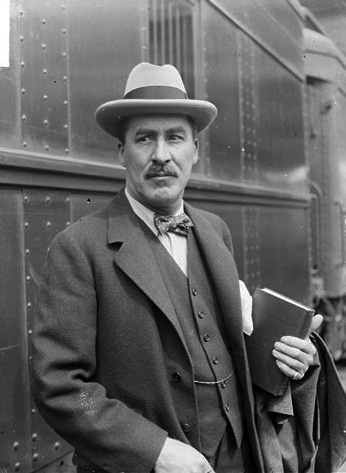
Howard Carter. SourceDeath Shall Come on Swift Wings To Him Who Disturbs the Peace of the King… – Supposedly engraved on the exterior of King Tutankhamen’s Tomb
The king was only nineteen when he died, perhaps murdered by his enemies. His tomb, in comparison with his contemporaries, was modest. After his death, his successors made an attempt to expunge his memory by removing his name from all the official records. Even those carved in stone. As it turns out, his enemy’s efforts only ensured his eventual fame. His name was Tutankhamen: King Tut.
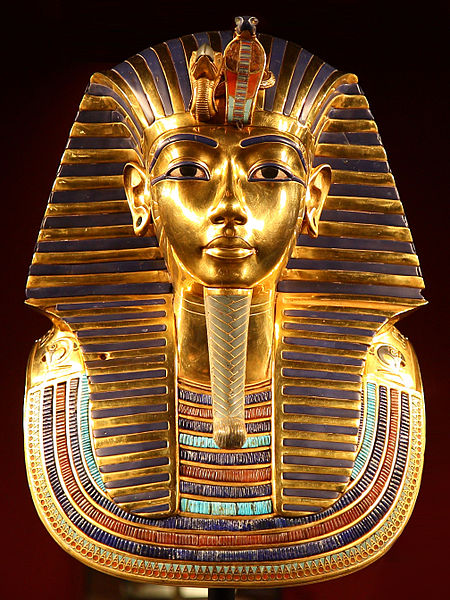
Tutankhamun. Source
https://learning.blogs.nytimes.com/2012/02/16/feb-16-1923-king-tuts-burial-chamber-unsealed/
Tomb of Tutankhamun :
Howard Carter unseals the burial chamber of Pharaoh Tutankhamun.
On 16 February 1923, Carter opened the sealed doorway and confirmed it led to a burial chamber, containing the sarcophagus of Tutankhamun. The tomb was considered the best preserved and most intact pharaonic tomb ever found in the Valley of the Kings, and the discovery was eagerly covered by the world's press. However, much to the annoyance of other newspapers, Lord Carnarvon sold exclusive reporting rights to The Times. Only H. V. Morton of that paper was allowed on the scene, and his vivid descriptions helped to establish Carter's reputation with the British public.
 :copyright: File Howard Carter (left) and Lord Carnarvon breaking into King Tutankhamun's tomb, 1923.
:copyright: File Howard Carter (left) and Lord Carnarvon breaking into King Tutankhamun's tomb, 1923.It may simply have been the luck of the draw, but no one has probably furthered the interests of Egyptology, and indeed the world’s archaeological focus on Egypt more than Howard Carter. His discovery of the tomb of Tutankhamun has inspired almost a century of Hollywood movies, books and media attention for this greatest of all living museums we call Egypt. While Howard Carter’s find of the mostly intact tomb of a pharaoh may have been lucky, it was the result of a dedicated career in Egyptology and the culmination of consistent exploration.

Howard Carter. Source
The king was only nineteen when he died, perhaps murdered by his enemies. His tomb, in comparison with his contemporaries, was modest. After his death, his successors made an attempt to expunge his memory by removing his name from all the official records. Even those carved in stone. As it turns out, his enemy’s efforts only ensured his eventual fame. His name was Tutankhamen: King Tut.

Tutankhamun. Source
https://learning.blogs.nytimes.com/2012/02/16/feb-16-1923-king-tuts-burial-chamber-unsealed/

gassey- BronzeProudly made in Wigan bronze award
- Posts : 4669
Join date : 2019-08-21
Age : 71
Location : Pemberton
 Re: Today in history
Re: Today in history
17 th February 1978
The La Mon restaurant bombing :
The Troubles: The Provisional IRA detonates an incendiary bomb at the La Mon restaurant, near Belfast, killing 12 and seriously injuring 30 others, all Protestants.
 The La Mon restaurant bombing was an incendiary bomb attack by the Provisional Irish Republican Army (IRA) on 17 February 1978 that has been described as “one of the worst atrocities” of the Troubles.
The La Mon restaurant bombing was an incendiary bomb attack by the Provisional Irish Republican Army (IRA) on 17 February 1978 that has been described as “one of the worst atrocities” of the Troubles.
It took place at the La Mon House hotel/restaurant near Belfast, Northern Ireland. The IRA left a large incendiary bomb, containing a napalm-like substance, outside one of the restaurant’s windows. There were 450 diners, hotel staff and guests inside the building. The IRA members then tried to send warnings by telephone, but were unable to do so until nine minutes before it detonated.
The blast created a fireball, killing twelve people and injuring thirty more, many of whom were severely burnt. Many of the injured were treated in the Ulster Hospital in nearby Dundonald.

After planting the bomb, the IRA members tried to send a warning from the nearest public telephone, but found that it had been vandalised. On their way to another telephone they were delayed again when forced to stop at an Ulster Defence Regiment (UDR) checkpoint.
By the time they were able to send the warning, only nine minutes remained before the bomb exploded at 21:00.The Royal Ulster Constabulary (RUC) base at Newtownards had received two further telephone warnings at 20:57 and 21:04.By the time the latter call came in it was too late. When an officer telephoned the restaurant to issue the warning he was told :
 Lilly McDowell suffered severe burns in the attack
Lilly McDowell suffered severe burns in the attack
https://en.m.wikipedia.org/wiki/La_Mon_restaurant_bombing
The La Mon restaurant bombing :
The Troubles: The Provisional IRA detonates an incendiary bomb at the La Mon restaurant, near Belfast, killing 12 and seriously injuring 30 others, all Protestants.
[size=39]La Mon restaurant bombing[/size]

It took place at the La Mon House hotel/restaurant near Belfast, Northern Ireland. The IRA left a large incendiary bomb, containing a napalm-like substance, outside one of the restaurant’s windows. There were 450 diners, hotel staff and guests inside the building. The IRA members then tried to send warnings by telephone, but were unable to do so until nine minutes before it detonated.
The blast created a fireball, killing twelve people and injuring thirty more, many of whom were severely burnt. Many of the injured were treated in the Ulster Hospital in nearby Dundonald.

After planting the bomb, the IRA members tried to send a warning from the nearest public telephone, but found that it had been vandalised. On their way to another telephone they were delayed again when forced to stop at an Ulster Defence Regiment (UDR) checkpoint.
By the time they were able to send the warning, only nine minutes remained before the bomb exploded at 21:00.The Royal Ulster Constabulary (RUC) base at Newtownards had received two further telephone warnings at 20:57 and 21:04.By the time the latter call came in it was too late. When an officer telephoned the restaurant to issue the warning he was told :
Although the bombers tried to warn of the bomb (the IRA often gave bomb warnings when destroying property but never when targeting the police or military), a 2012 news article claimed that the IRA were targeting RUC officers they believed were meeting in the restaurant that night. The article claimed that the IRA had got the wrong date and that the meeting of RUC officers had taken place exactly a week before.“For God’s sake, get out here – a bomb has exploded!”.
 Lilly McDowell suffered severe burns in the attack
Lilly McDowell suffered severe burns in the attack————————————–
https://en.m.wikipedia.org/wiki/La_Mon_restaurant_bombing

gassey- BronzeProudly made in Wigan bronze award
- Posts : 4669
Join date : 2019-08-21
Age : 71
Location : Pemberton
 Re: Today in history
Re: Today in history
18 th February 1930
Elm farm Ollie , the first flying cow :
Elm Farm Ollie becomes the first cow to fly in a fixed-wing aircraft and also the first cow to be milked in an aircraft .
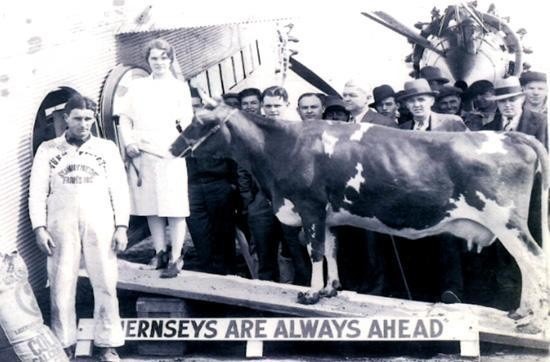
On February 18, 1930, the first cow to ever take flight ascended into the sky in a Ford Tri-Motor. As part of the celebration of the International Air Exposition in St. Louis, Elm Farm Ollie was flown from Bismarck, Missouri to St. Louis, a distance of 72 miles. Elm Farm Ollie was the first cow to take flight and the first cow to be milked on a plane.

 Elm Farm Ollie was reported to have been an unusually productive Guernsey cow, requiring three milkings a day and producing 24 quarts of milk during the flight itself. Wisconsin native Elsworth W. Bunce milked her, becoming the first man to milk a cow mid-flight. Elm Farm Ollie’s milk was sealed into paper cartons which were parachuted to spectators below. Charles Lindbergh reportedly received a glass of the milk
Elm Farm Ollie was reported to have been an unusually productive Guernsey cow, requiring three milkings a day and producing 24 quarts of milk during the flight itself. Wisconsin native Elsworth W. Bunce milked her, becoming the first man to milk a cow mid-flight. Elm Farm Ollie’s milk was sealed into paper cartons which were parachuted to spectators below. Charles Lindbergh reportedly received a glass of the milk
https://en.m.wikipedia.org/wiki/Elm_Farm_Ollie
Elm farm Ollie , the first flying cow :
Elm Farm Ollie becomes the first cow to fly in a fixed-wing aircraft and also the first cow to be milked in an aircraft .

On February 18, 1930, the first cow to ever take flight ascended into the sky in a Ford Tri-Motor. As part of the celebration of the International Air Exposition in St. Louis, Elm Farm Ollie was flown from Bismarck, Missouri to St. Louis, a distance of 72 miles. Elm Farm Ollie was the first cow to take flight and the first cow to be milked on a plane.

Painting of Elm Farm Ollie by E.D. Thalinger in
 Elm Farm Ollie was reported to have been an unusually productive Guernsey cow, requiring three milkings a day and producing 24 quarts of milk during the flight itself. Wisconsin native Elsworth W. Bunce milked her, becoming the first man to milk a cow mid-flight. Elm Farm Ollie’s milk was sealed into paper cartons which were parachuted to spectators below. Charles Lindbergh reportedly received a glass of the milk
Elm Farm Ollie was reported to have been an unusually productive Guernsey cow, requiring three milkings a day and producing 24 quarts of milk during the flight itself. Wisconsin native Elsworth W. Bunce milked her, becoming the first man to milk a cow mid-flight. Elm Farm Ollie’s milk was sealed into paper cartons which were parachuted to spectators below. Charles Lindbergh reportedly received a glass of the milkhttps://en.m.wikipedia.org/wiki/Elm_Farm_Ollie

gassey- BronzeProudly made in Wigan bronze award
- Posts : 4669
Join date : 2019-08-21
Age : 71
Location : Pemberton
 Re: Today in history
Re: Today in history
19 th February 1878
Thomas Edison patents his phonograph ( predecessor of the compact disc ):
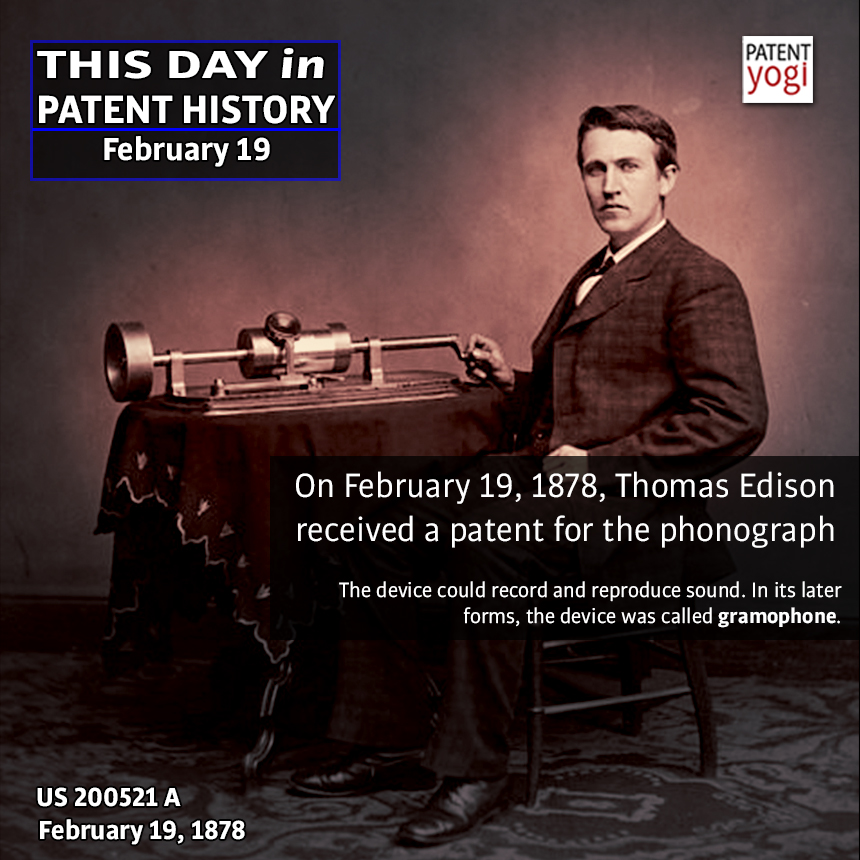

The disc phonograph record was the dominant audio recording format throughout most of the 20th century. From the mid-1980s, phonograph use declined sharply because of the rise of the compact disc and other digital recording formats.
https://www.loc.gov/collections/edison-company-motion-pictures-and-sound-recordings/articles-and-essays/history-of-edison-sound-recordings/history-of-the-cylinder-phonograph/
Thomas Edison patents his phonograph ( predecessor of the compact disc ):

On February 19, 1878, Thomas Edison received a patent for the phonograph.
The photo shows Thomas Edison with his patented phonograph.The device could mechanically record and reproduce sound. In its later forms, the device was called gramophone. While other inventors had produced devices that could record sounds, Edison’s phonograph was the first to be able to reproduce the recorded sound.
The sound vibration waveforms are recorded as corresponding physical deviations of a spiral groove engraved, etched, incised, or impressed into the surface of a rotating cylinder or disc, called a “record”. To recreate the sound, the surface is similarly rotated while a playback stylus traces the groove and is therefore vibrated by it, very faintly reproducing the recorded sound. In early acoustic phonographs, the stylus vibrated a diaphragm which produced sound waves which were coupled to the open air through a flaring horn, or directly to the listener’s ears through stethoscope-type earphones.

Edison cylinder phonograph, circa 1899
The disc phonograph record was the dominant audio recording format throughout most of the 20th century. From the mid-1980s, phonograph use declined sharply because of the rise of the compact disc and other digital recording formats.
https://www.loc.gov/collections/edison-company-motion-pictures-and-sound-recordings/articles-and-essays/history-of-edison-sound-recordings/history-of-the-cylinder-phonograph/

gassey- BronzeProudly made in Wigan bronze award
- Posts : 4669
Join date : 2019-08-21
Age : 71
Location : Pemberton
 Re: Today in history
Re: Today in history
20 th February 2003
The Station nightclub fire :
During a Great White concert in West Warwick, Rhode Island, a pyrotechnics display sets the Station nightclub ablaze, killing 100 and injuring over 200 others .
A fire occurred on the night of Feb. 20, 2003, in The Station nightclub at 211 Cowesett Avenue, West Warwick, Rhode Island. A band that was performing that night used pyrotechnics that ignited polyurethane foam insulation lining the walls and ceiling of the stage platform. The fire spread quickly along the ceiling area over the dance floor. Smoke was visible in the exit doorways in a little more than one minute, and flames were observed breaking through a portion of the roof in less than five minutes. Egress from the nightclub, which was not equipped with sprinklers, was hampered by crowding at the main entrance to the building. One hundred people lost their lives in the fire. Of the fatalities, 95 were due to the inability of the occupants to evacuate before being overcome by the untenable conditions along the egress path.
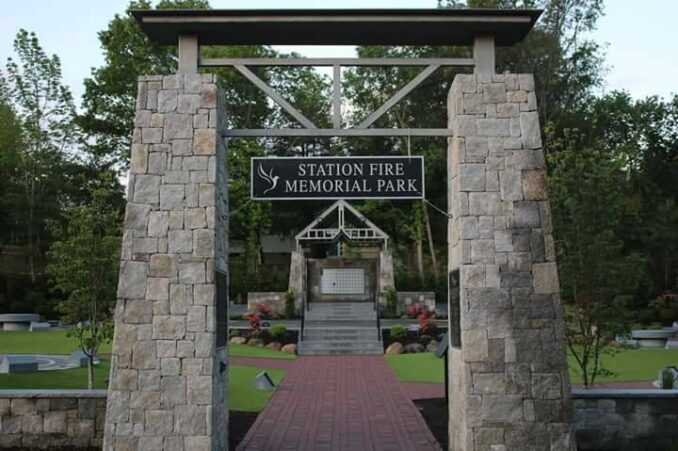
The fire started at the West Warwick club when a manager for the band Great White set off pyrotechnics for the band's show. The sparks ignited foam soundproofing that lined the club's walls. Fueled by the flammable foam, the fire spread quickly, trapping many people inside.
In May 2017, a memorial park for those who died in the Feb. 20, 2003, fire was opened at the site. The Station Fire Memorial Foundation doesn't have any formal events for this year's anniversary, although friends and families of fire victims often visit the memorial informally.

A silk bouquet provides a hint of spring as dawn breaks over the snowy park Friday.
[size=13]BOB BREIDENBACH/THE PROVIDENCE JOURNAL[/size]
"We will not host a big memorial until the 20th anniversary in 2023," said Gina Russo, president of the Station Fire Memorial Foundation.
https://en.m.wikipedia.org/wiki/The_Station_nightclub_fire
The Station nightclub fire :
During a Great White concert in West Warwick, Rhode Island, a pyrotechnics display sets the Station nightclub ablaze, killing 100 and injuring over 200 others .
A fire occurred on the night of Feb. 20, 2003, in The Station nightclub at 211 Cowesett Avenue, West Warwick, Rhode Island. A band that was performing that night used pyrotechnics that ignited polyurethane foam insulation lining the walls and ceiling of the stage platform. The fire spread quickly along the ceiling area over the dance floor. Smoke was visible in the exit doorways in a little more than one minute, and flames were observed breaking through a portion of the roof in less than five minutes. Egress from the nightclub, which was not equipped with sprinklers, was hampered by crowding at the main entrance to the building. One hundred people lost their lives in the fire. Of the fatalities, 95 were due to the inability of the occupants to evacuate before being overcome by the untenable conditions along the egress path.

The fire started at the West Warwick club when a manager for the band Great White set off pyrotechnics for the band's show. The sparks ignited foam soundproofing that lined the club's walls. Fueled by the flammable foam, the fire spread quickly, trapping many people inside.
In May 2017, a memorial park for those who died in the Feb. 20, 2003, fire was opened at the site. The Station Fire Memorial Foundation doesn't have any formal events for this year's anniversary, although friends and families of fire victims often visit the memorial informally.
A silk bouquet provides a hint of spring as dawn breaks over the snowy park Friday.
[size=13]BOB BREIDENBACH/THE PROVIDENCE JOURNAL[/size]
"We will not host a big memorial until the 20th anniversary in 2023," said Gina Russo, president of the Station Fire Memorial Foundation.
https://en.m.wikipedia.org/wiki/The_Station_nightclub_fire

gassey- BronzeProudly made in Wigan bronze award
- Posts : 4669
Join date : 2019-08-21
Age : 71
Location : Pemberton
 Re: Today in history
Re: Today in history
21 st February 1804
The first steam trains :
The first self-propelling steam locomotive makes its outing at the Pen-y-Darren Ironworks in Wales.
The replica locomotive in its present home, the National Waterfront Museum.
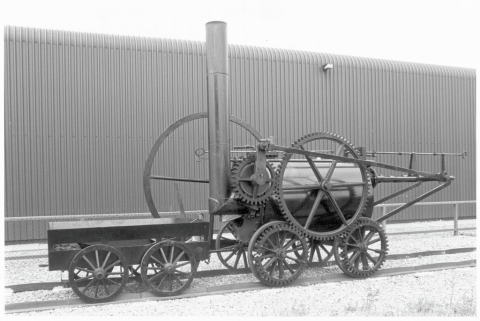
Trevithick's Penydarren locomotive and tender at W.I.M.M. in 1983.
http://www.victorianweb.org/technology/railway1.html
The first steam trains :
The first self-propelling steam locomotive makes its outing at the Pen-y-Darren Ironworks in Wales.
The replica locomotive in its present home, the National Waterfront Museum.

Trevithick's Penydarren locomotive and tender at W.I.M.M. in 1983.
The Penydarren loco
On 21 February 1804, the world's first ever railway journey ran 9 miles from the ironworks at Penydarren to the Merthyr-Cardiff Canal, South Wales. It was to be several years before steam locomotion became commercially viable, meaning Richard Trevithick and not George Stephenson was the real father of the railways.http://www.victorianweb.org/technology/railway1.html

gassey- BronzeProudly made in Wigan bronze award
- Posts : 4669
Join date : 2019-08-21
Age : 71
Location : Pemberton
 Re: Today in history
Re: Today in history
22 nd February 2006
The Securitas depot robbery Britains biggest heist :
At least six men stage Britain's biggest robbery, stealing £53m from a Securitas depot in Tonbridge, Kent.

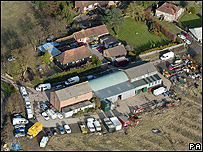
The money was first taken to Elderden Farm in Kent
https://en.m.wikipedia.org/wiki/Securitas_depot_robbery
The Securitas depot robbery Britains biggest heist :
At least six men stage Britain's biggest robbery, stealing £53m from a Securitas depot in Tonbridge, Kent.
The Securitas depot robbery was the largest cash robbery in British history. It took place on the evening of 21 February 2006 from 18:30 GMT until the early hours of 22 February 2006. Several men abducted and threatened the family of the manager, tied up fourteen staff members and stole £53,116,760 in bank notes from a Securitas Cash Management Ltd depot in Vale Road, Tonbridge, Kent.
Robbery
The manager of the depot, Colin Dixon, was abducted at about 18:30 on 21 February 2006, while driving his silver Nissan Almera. He was pulled over on the A249 just outside Stockbury, a village north east of Maidstone, by what he thought was an unmarked police vehicle, due to the blue lights behind the front grill. A man approached him in high-visibility clothing and a police-style hat. The manager proceeded to get into the police impostor’s car, thinking that he was a police officer, where he was then handcuffed by others in the vehicle. He was then driven west on the M20 motorway to the West Malling bypass, where he was bound further, transferred into a white van and transported to a farm in Staplehurst, Kent.
As this was taking place, the manager’s wife and eight-year-old son were being held hostage at their home in Herne Bay, after they answered the door to men dressed in police uniforms, who falsely informed them that the manager had been involved in a road traffic accident. They were then driven to the farm at which the manager was being held, where he was told, at gunpoint, that failure to co-operate could put him and his family in danger.
The depot manager, his wife and son were taken to the Securitas depot in Tonbridge at around 01:00, travelling in a plain white van, being held at gunpoint. At the depot, 14 members of staff were bound by robbers armed with handguns, shotguns, a Skorpion and AK-47s and wearing balaclavas.
The robbery came to an end at approximately 02:45. The staff, along with Mr Dixon’s wife and son, were left locked in cash cages. However, one member of staff had a key to unlock the cage she was locked in; she was then able to free the others. It was still another half an hour before staff members, who had been tied up, managed to raise the alarm. Police officers arriving on the scene discovered staff, the manager and his family all bound, but physically unharmed.
The Bank of England, to whom the money belonged, was reimbursed £25 million by Securitas AB the same day, and assured the public that Securitas would make up any additional loss.


The money was first taken to Elderden Farm in Kent
https://en.m.wikipedia.org/wiki/Securitas_depot_robbery

gassey- BronzeProudly made in Wigan bronze award
- Posts : 4669
Join date : 2019-08-21
Age : 71
Location : Pemberton
 Re: Today in history
Re: Today in history
23 rd February 2007
The Greyrigg train de-railment :
A train derails on an evening express service near Grayrigg, Cumbria, England, killing one person and injuring 88. This results in hundreds of points being checked over the UK after a few similar accidents.

[size=10]The derailed Virgin train at Grayrigg, Cumbria. Photograph: Getty[/size]
On Friday 23 February 2007 a Virgin West Coast train from London Euston to Glasgow derailed on 2B points at Lambrigg, near Grayrigg in Cumbria, while travelling at the authorised speed of 95mph (153 km/h). All nine carriages of the Class 390 Pendolino were derailed. There were at least 105 passengers and four crew on board. One passenger was fatally injured, 28 passengers, the train driver and one other crew member were seriously injured, and 59 passengers received minor injuries.
The immediate cause of the derailment was the deterioration of 2B points through a combination of failures of the three stretcher bars, the lock stretcher bar, and their fastenings. This allowed the left-hand switch rail to move into an unsafe position close to its stock rail, without losing signalling detection. This came about as a result of a combination of three factors, which were:
All three factors were necessary for the accident to occur.
 IMAGE COPYRIGHTGETTY IMAGES
IMAGE COPYRIGHTGETTY IMAGES
image captionNetwork Rail was fined £4m after admitting health and safety breaches over the "degraded and "unsafe" set of points
David Lewis, an engineer with the company, broke down in tears on Monday when he told the Kendal hearing he had forgotten to inspect the points near where the crash happened.
He said he was "under pressure" when he failed to check a section of the rail line five days before the derailment.
He told the inquest he felt like a man "spinning plates on sticks".
His colleague Paul Wills, an assistant track section manager, told the inquest that staff had to put up with "bully-boy" management.
The 11 jurors had heard how a subsequent Rail Accident Investigation Branch (RAIB) inquiry ruled the "immediate cause" of the crash was that the train had gone over a "degraded and unsafe" set of points, known as Lambrigg 2B.
https://en.m.wikipedia.org/wiki/Grayrigg_derailment
The Greyrigg train de-railment :
A train derails on an evening express service near Grayrigg, Cumbria, England, killing one person and injuring 88. This results in hundreds of points being checked over the UK after a few similar accidents.

[size=10]The derailed Virgin train at Grayrigg, Cumbria. Photograph: Getty[/size]
On Friday 23 February 2007 a Virgin West Coast train from London Euston to Glasgow derailed on 2B points at Lambrigg, near Grayrigg in Cumbria, while travelling at the authorised speed of 95mph (153 km/h). All nine carriages of the Class 390 Pendolino were derailed. There were at least 105 passengers and four crew on board. One passenger was fatally injured, 28 passengers, the train driver and one other crew member were seriously injured, and 59 passengers received minor injuries.
The immediate cause of the derailment was the deterioration of 2B points through a combination of failures of the three stretcher bars, the lock stretcher bar, and their fastenings. This allowed the left-hand switch rail to move into an unsafe position close to its stock rail, without losing signalling detection. This came about as a result of a combination of three factors, which were:
- the mechanical failure of a bolted joint
- the incorrect set up the points
- a track inspection that was missed on 18 February 2007.
All three factors were necessary for the accident to occur.
 IMAGE COPYRIGHTGETTY IMAGES
IMAGE COPYRIGHTGETTY IMAGESimage captionNetwork Rail was fined £4m after admitting health and safety breaches over the "degraded and "unsafe" set of points
David Lewis, an engineer with the company, broke down in tears on Monday when he told the Kendal hearing he had forgotten to inspect the points near where the crash happened.
He said he was "under pressure" when he failed to check a section of the rail line five days before the derailment.
He told the inquest he felt like a man "spinning plates on sticks".
His colleague Paul Wills, an assistant track section manager, told the inquest that staff had to put up with "bully-boy" management.
The 11 jurors had heard how a subsequent Rail Accident Investigation Branch (RAIB) inquiry ruled the "immediate cause" of the crash was that the train had gone over a "degraded and unsafe" set of points, known as Lambrigg 2B.
https://en.m.wikipedia.org/wiki/Grayrigg_derailment

gassey- BronzeProudly made in Wigan bronze award
- Posts : 4669
Join date : 2019-08-21
Age : 71
Location : Pemberton
 Re: Today in history
Re: Today in history
24 th February 1920
Lady Astor , first lady to speak in the House of commons :
Nancy Astor becomes the first woman to speak in the House of Commons of the United Kingdom following her election as a Member of Parliament (MP) three months earlier.
A master of repartee, Nancy Astor needed to have all her wits about her to survive in the male dominated arena of politics. She gained attention as someone who did not follow the rules – for example, when David Lloyd George was called to swear her in he set off before the others and was pulled back and scolded by Nancy. On another occasion, her first day in the House of Commons, she was called to order for chatting with a fellow House member, not realising she was who was causing the commotion.
Nancy quickly became known for her outspoken views of specific issues, including advocating women’s rights and stricter restrictions on alcohol. Yet, despite claiming to be an ardent feminist, suffrage campaigners were initially dismayed that the first female MP had never had ties to their movement.
On 24 February 1920, Nancy stood alone amongst an audience of over 500, mostly hostile, male MPs to deliver her maiden speech. In her speech she referred to the fact that some women over the age of 30 could now vote in Britain: ‘You must remember that women have got a vote now and we mean to use it, and use it wisely’ and also spoke about the perils of drinking, emphasising the damage it caused to women and children, as well as the economic cost to the country, and appealing for stricter restrictions on the drinking hours that had come into effect during the First World
Describing Nancy Astor’s maiden speech, the historian and Liberal MP Herbert Fisher told the Commons that her maiden speech was one ‘brilliant and vivid eloquence’. He added that he felt it appropriate that ‘the first speech delivered in this historic assembly by a woman should have been delivered upon a topic in which the interests of women are so closely involved’. The Commons debate was on whether or not there should be a relaxation of the restrictions imposed on the alcohol trade during the Great War. The motion was brought before a nearly full House, so over 500 MPs were there to hear Nancy Astor oppose the move of a fellow Unionist MP, Sir John David Rees (Nottingham East). Rees claimed that the current controls were ‘vexatious and unnecessary’.
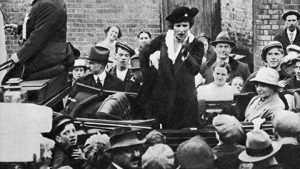
Lady Astor rose to her feet to argue that they were neither.
 IMAGE COPYRIGHTGETTY IMAGES
IMAGE COPYRIGHTGETTY IMAGES
image captionLady Astor campaigning for her seat again in 1923
https://www.thehistorypress.co.uk/articles/nancy-astor-the-first-lady-of-british-politics/
Lady Astor , first lady to speak in the House of commons :
Nancy Astor becomes the first woman to speak in the House of Commons of the United Kingdom following her election as a Member of Parliament (MP) three months earlier.
A master of repartee, Nancy Astor needed to have all her wits about her to survive in the male dominated arena of politics. She gained attention as someone who did not follow the rules – for example, when David Lloyd George was called to swear her in he set off before the others and was pulled back and scolded by Nancy. On another occasion, her first day in the House of Commons, she was called to order for chatting with a fellow House member, not realising she was who was causing the commotion.
Nancy quickly became known for her outspoken views of specific issues, including advocating women’s rights and stricter restrictions on alcohol. Yet, despite claiming to be an ardent feminist, suffrage campaigners were initially dismayed that the first female MP had never had ties to their movement.
On 24 February 1920, Nancy stood alone amongst an audience of over 500, mostly hostile, male MPs to deliver her maiden speech. In her speech she referred to the fact that some women over the age of 30 could now vote in Britain: ‘You must remember that women have got a vote now and we mean to use it, and use it wisely’ and also spoke about the perils of drinking, emphasising the damage it caused to women and children, as well as the economic cost to the country, and appealing for stricter restrictions on the drinking hours that had come into effect during the First World
Describing Nancy Astor’s maiden speech, the historian and Liberal MP Herbert Fisher told the Commons that her maiden speech was one ‘brilliant and vivid eloquence’. He added that he felt it appropriate that ‘the first speech delivered in this historic assembly by a woman should have been delivered upon a topic in which the interests of women are so closely involved’. The Commons debate was on whether or not there should be a relaxation of the restrictions imposed on the alcohol trade during the Great War. The motion was brought before a nearly full House, so over 500 MPs were there to hear Nancy Astor oppose the move of a fellow Unionist MP, Sir John David Rees (Nottingham East). Rees claimed that the current controls were ‘vexatious and unnecessary’.

Lady Astor rose to her feet to argue that they were neither.
 IMAGE COPYRIGHTGETTY IMAGES
IMAGE COPYRIGHTGETTY IMAGESimage captionLady Astor campaigning for her seat again in 1923
https://www.thehistorypress.co.uk/articles/nancy-astor-the-first-lady-of-british-politics/

gassey- BronzeProudly made in Wigan bronze award
- Posts : 4669
Join date : 2019-08-21
Age : 71
Location : Pemberton
 Re: Today in history
Re: Today in history
25 th February 1939
The first Anderson shelter :
As part of British air raid precautions, the first of 21⁄2 million Anderson shelters is constructed in a garden in Islington, north London
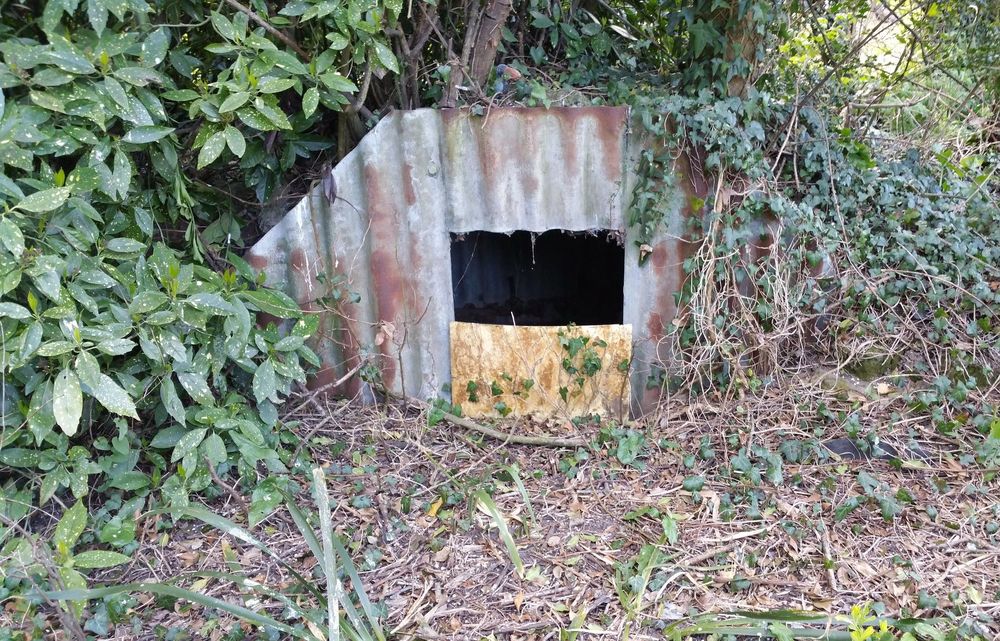
A surviving Anderson Shelter in Manston, Kent. Photo: Dan Thompson/Flickr
The first Anderson shelter was erected in a garden in Islington, London, on 25 February 1939. By the time the war broke out in September, around 1.5 million shelters were in place in areas expected to be bombed by the Luftwaffe. During the war a further 2.1 million were erected.

A small air raid shelter designed for people to erect on their properties in preparation for the expected bombing campaigns of World War II, the first of London’s ‘Anderson’ shelters were rolled out 80 years ago in a backyard garden of a house in Islington on 25th February, 1939.
Anderson commissioned the engineer William Patterson to design a small and cheap shelter that could be erected in people's gardens. The first 'Anderson' shelter was erected in a garden in Islington, London on 25 February 1939 and, between then and the outbreak of the war in September, around 1.5 million shelters were distributed to people living in areas expected to be bombed by the Luftwaffe. During the war a further 2.1 million were erected.
[size=18] Anderson shelters were issued free to all householders who earned less than £250 a year.
Anderson shelters were issued free to all householders who earned less than £250 a year.
https://www.andersonshelters.org.uk/history.html
The first Anderson shelter :
As part of British air raid precautions, the first of 21⁄2 million Anderson shelters is constructed in a garden in Islington, north London

A surviving Anderson Shelter in Manston, Kent. Photo: Dan Thompson/Flickr
The first Anderson shelter was erected in a garden in Islington, London, on 25 February 1939. By the time the war broke out in September, around 1.5 million shelters were in place in areas expected to be bombed by the Luftwaffe. During the war a further 2.1 million were erected.

A small air raid shelter designed for people to erect on their properties in preparation for the expected bombing campaigns of World War II, the first of London’s ‘Anderson’ shelters were rolled out 80 years ago in a backyard garden of a house in Islington on 25th February, 1939.
Anderson commissioned the engineer William Patterson to design a small and cheap shelter that could be erected in people's gardens. The first 'Anderson' shelter was erected in a garden in Islington, London on 25 February 1939 and, between then and the outbreak of the war in September, around 1.5 million shelters were distributed to people living in areas expected to be bombed by the Luftwaffe. During the war a further 2.1 million were erected.
[size=18]
 Anderson shelters were issued free to all householders who earned less than £250 a year.
Anderson shelters were issued free to all householders who earned less than £250 a year.https://www.andersonshelters.org.uk/history.html

gassey- BronzeProudly made in Wigan bronze award
- Posts : 4669
Join date : 2019-08-21
Age : 71
Location : Pemberton
 Re: Today in history
Re: Today in history
26 th February 1960
The Shannon airport airliner disaster :
A New York-bound Alitalia airliner crashes into a cemetery in Shannon, Ireland, shortly after takeoff, killing 34 of the 52 persons on board.
Alitalia flight 618 was a scheduled service from Rome, Italy, to New York, NY, USA, with a refueling stop at Shannon, Ireland.
The flight was being flown under the supervision of a check pilot.
The aircraft, a Douglas DC-7C, arrived at Shannon without incident and after refueling, it was cleared to take off from runway. The weather was clear but dark and partially overcast.
The take-off from runway 05 was normal except that the ground roll was probably slightly prolonged. The landing gear was retracted normally. A turn to the left was begun very shortly after gear retraction when the aircraft had climbed to about 165 ft. Power was reduced from take-off power to alternate climb power (2080 BHP) shortly after the turn had been initiated. The flaps, which had been at either 20° or 10° initially, were not fully retracted prior to power reduction. Following power reduction, the aircraft accelerated instead of climbing and lost height while still turning. The landing lights were on during the flight. The aircraft struck the ground while still in a left turn - the point of impact being 65 ft amsl. The left wing tip made the initial contact. The left propellers (Nos. 1 and 2) and left wing struck the stone wall and grave stones of Clonloghan Church. The tips of No. 3 propeller first struck the wall and then made cuts in the turf. The speed of the aircraft at impact was of the order of 170 - 180 kt.
The aircraft was completely destroyed by impact and subsequent explosion and fire. One steward and seventeen passengers survived the accident.
Air Italia Crash at Shannon Airport.26/02/1960..An Alitalia Douglas DC-7C crashed after taking off from the airport, killing 34 people out of 52 passengers and crew on board...The Alitalia flight, on the Roma-Shannon-New York route, was being flown under the supervision of a check pilot. The aircraft took off from runway 05 and a left turn was initiated at 165 feet height. Height was lost during the turn, and the left wing tip contacted the ground. The left wing and no. 1 and 2 propellers then struck the stone wall and grave stones of the Clonloghan Church.

Air Italia Crash at Shannon Airport.26/02/1960..An Alitalia Douglas DC-7C crashed after taking off from the airport, killing 34 people out of 52 passengers and crew on board...The Alitalia flight, on the Roma-Shannon-New York route, was being flown under the supervision of a check pilot. The aircraft took off from runway 05 and a left turn was initiated at 165 feet height. Height was lost during the turn, and the left wing tip contacted the ground. The left wing and no. 1 and 2 propellers then struck the stone wall and grave stones of the Clonloghan Church. The DC-7 then impacted the ground at a 170-180 knots airspeed...An official investigation following the crash concluded: "No definite evidence leading to a particular reason for this accident was revealed by the investigation. It can only be concluded that the aeroplane lost height in a turn shortly after takeoff and struck the ground."

https://en.m.wikipedia.org/wiki/Alitalia_Flight_618
The Shannon airport airliner disaster :
A New York-bound Alitalia airliner crashes into a cemetery in Shannon, Ireland, shortly after takeoff, killing 34 of the 52 persons on board.
Alitalia flight 618 was a scheduled service from Rome, Italy, to New York, NY, USA, with a refueling stop at Shannon, Ireland.
The flight was being flown under the supervision of a check pilot.
The aircraft, a Douglas DC-7C, arrived at Shannon without incident and after refueling, it was cleared to take off from runway. The weather was clear but dark and partially overcast.
The take-off from runway 05 was normal except that the ground roll was probably slightly prolonged. The landing gear was retracted normally. A turn to the left was begun very shortly after gear retraction when the aircraft had climbed to about 165 ft. Power was reduced from take-off power to alternate climb power (2080 BHP) shortly after the turn had been initiated. The flaps, which had been at either 20° or 10° initially, were not fully retracted prior to power reduction. Following power reduction, the aircraft accelerated instead of climbing and lost height while still turning. The landing lights were on during the flight. The aircraft struck the ground while still in a left turn - the point of impact being 65 ft amsl. The left wing tip made the initial contact. The left propellers (Nos. 1 and 2) and left wing struck the stone wall and grave stones of Clonloghan Church. The tips of No. 3 propeller first struck the wall and then made cuts in the turf. The speed of the aircraft at impact was of the order of 170 - 180 kt.
The aircraft was completely destroyed by impact and subsequent explosion and fire. One steward and seventeen passengers survived the accident.
Air Italia Crash at Shannon Airport.26/02/1960..An Alitalia Douglas DC-7C crashed after taking off from the airport, killing 34 people out of 52 passengers and crew on board...The Alitalia flight, on the Roma-Shannon-New York route, was being flown under the supervision of a check pilot. The aircraft took off from runway 05 and a left turn was initiated at 165 feet height. Height was lost during the turn, and the left wing tip contacted the ground. The left wing and no. 1 and 2 propellers then struck the stone wall and grave stones of the Clonloghan Church.

Air Italia Crash at Shannon Airport.26/02/1960..An Alitalia Douglas DC-7C crashed after taking off from the airport, killing 34 people out of 52 passengers and crew on board...The Alitalia flight, on the Roma-Shannon-New York route, was being flown under the supervision of a check pilot. The aircraft took off from runway 05 and a left turn was initiated at 165 feet height. Height was lost during the turn, and the left wing tip contacted the ground. The left wing and no. 1 and 2 propellers then struck the stone wall and grave stones of the Clonloghan Church. The DC-7 then impacted the ground at a 170-180 knots airspeed...An official investigation following the crash concluded: "No definite evidence leading to a particular reason for this accident was revealed by the investigation. It can only be concluded that the aeroplane lost height in a turn shortly after takeoff and struck the ground."
Add to Cart
Filename1960 - 26/02 Alitalia Crash at Shannon Airport B321-2387.jpgCopyrightSingle use for this image - .Copyrighted to SKP & Associates Ltd trading as Lensmen & Associates, Lensmen Photographic Agency and.Lensmen Photographic Archive...COPYRIGHT AND RELATED RIGHTS ACT, 2000..Under the Copyright and Related Rights Act, 2000 the cImage Size1826x1395 / 852.4KB
https://en.m.wikipedia.org/wiki/Alitalia_Flight_618

gassey- BronzeProudly made in Wigan bronze award
- Posts : 4669
Join date : 2019-08-21
Age : 71
Location : Pemberton
 Re: Today in history
Re: Today in history
27 th February 1900
The Labour party :
The British Labour Party is founded .
1900: How was the British Labour Party Formed?


On the first elections that they participated in (1900), the Labour Party won only two seats in the parliament, which is not surprising considering that they allegedly spent only 33 pounds on those elections. However, already in 1910, the Labour Party received as many as 40 seats in Parliament. In 1924 Labour Party member Ramsay MacDonald became Britain’s Prime Minister, which was a major victory for the Labour Party.
https://en.m.wikipedia.org/wiki/History_of_the_Labour_Party_(UK)
The Labour party :
The British Labour Party is founded .
1900: How was the British Labour Party Formed?

On this day the British Labour Party celebrates the anniversary of its founding. Namely, on 27 February 1900, the so-called “Labour Representation Committee” was founded at a meeting in London – a direct predecessor of the Labour Party. Ramsay MacDonald was appointed as secretary, and he was actually a Scot rather than an Englishman. He later also became the first Labour Prime Minister in the history of Great Britain.
The Labour Party were actually formed as a conglomeration of various labor and leftist organizations. From the very beginning they had a certain detachment from socialism in the true sense of the word. However, the right-wingers marked them as “socialists”, so Winston Churchill for example, a member of the Conservative Party, accordingly called their government a “socialist government”
[size=14][size=15]28 February 1900: A conference in London calls for ‘the formation of a distinct labour group in parliament with their own Whips’[/size][/size]
On the first elections that they participated in (1900), the Labour Party won only two seats in the parliament, which is not surprising considering that they allegedly spent only 33 pounds on those elections. However, already in 1910, the Labour Party received as many as 40 seats in Parliament. In 1924 Labour Party member Ramsay MacDonald became Britain’s Prime Minister, which was a major victory for the Labour Party.
https://en.m.wikipedia.org/wiki/History_of_the_Labour_Party_(UK)

gassey- BronzeProudly made in Wigan bronze award
- Posts : 4669
Join date : 2019-08-21
Age : 71
Location : Pemberton
 Re: Today in history
Re: Today in history
28 th February 1975
The Moorgate tube disaster :
In London, an underground train fails to stop at Moorgate terminus station and crashes into the end of the tunnel, killing 43 people.
Mystery has surrounded the cause of the accident, and to this day no-one has been able to explain why it happened. The Official Department of the Environment Report on the accident (RAIL 1053/161/5) reveals that the train was old, dating from 1938, but it and the braking system were all in good working order.
The report includes statements from work colleagues who say that the driver, Leslie Newson, was known to be naturally cautious in his driving habits. A quiet man with few friends, he always wore his uniform in full and rarely drank alcohol. His usual practise when approaching stations was to slow down early and let the train coast into position at the platform.
A post mortem showed that he had not had a heart attack, nor had he suffered an epileptic fit. The previous day he had asked his wife to withdraw some money with which he planned to buy his daughter a car – not the actions of someone intent on suicide, although the press made the point that he had not even raised his hands to protect his face when the crash occurred. The guard on the train stated that Newson had ominously overshot at another station the previous week.
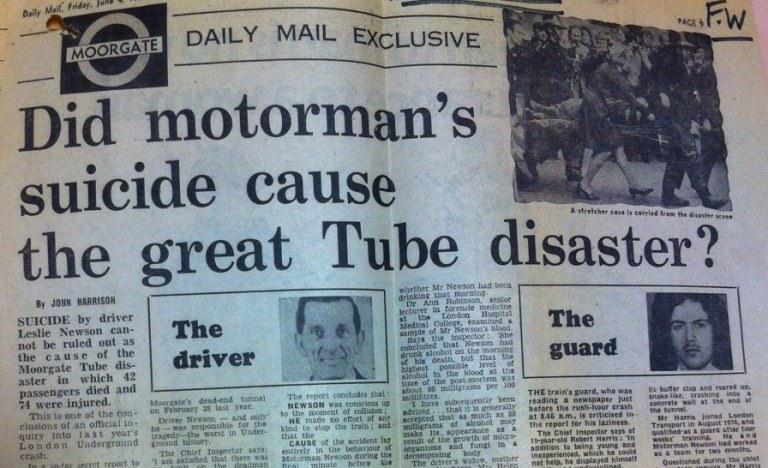
Following the disaster London Transport introduced a permanent 10mph speed limit on all trains entering ‘dead end’ passenger locations, as referenced in the British Railways Board Operations file AN 183/15. In 1978 a system called ‘Moorgate Protection’ was introduced, which automatically applied the brakes if the driver had failed to do so.
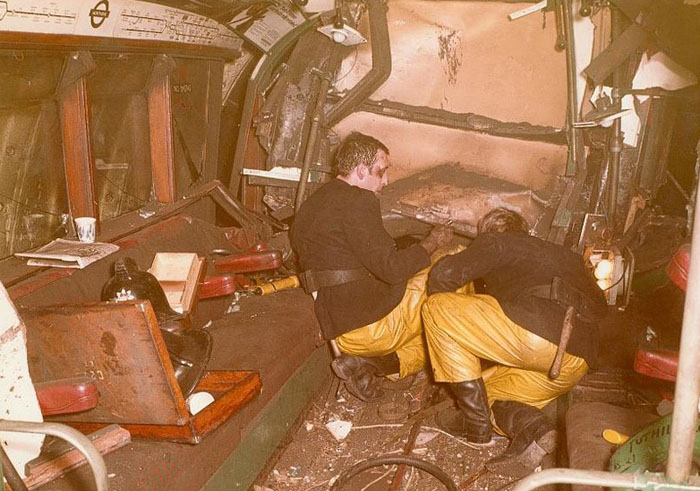
[size=21]Steve Gleeson who was part of Lambeth blue watch that day, recounts his memories of the incident. Steve said:
"We were immediately told to get our spreading and cutting gear and take it down to the platform level. As we were taking our gear down, firefighters were guiding casualties, covered in dust and grime, up the other escalators to safety, as well as to grab more equipment."[/size]
https://en.m.wikipedia.org/wiki/Moorgate_tube_crash
The Moorgate tube disaster :
In London, an underground train fails to stop at Moorgate terminus station and crashes into the end of the tunnel, killing 43 people.
Mystery has surrounded the cause of the accident, and to this day no-one has been able to explain why it happened. The Official Department of the Environment Report on the accident (RAIL 1053/161/5) reveals that the train was old, dating from 1938, but it and the braking system were all in good working order.
The report includes statements from work colleagues who say that the driver, Leslie Newson, was known to be naturally cautious in his driving habits. A quiet man with few friends, he always wore his uniform in full and rarely drank alcohol. His usual practise when approaching stations was to slow down early and let the train coast into position at the platform.
A post mortem showed that he had not had a heart attack, nor had he suffered an epileptic fit. The previous day he had asked his wife to withdraw some money with which he planned to buy his daughter a car – not the actions of someone intent on suicide, although the press made the point that he had not even raised his hands to protect his face when the crash occurred. The guard on the train stated that Newson had ominously overshot at another station the previous week.

Newspaper report, catalogue reference: AN 183/15.
Following the disaster London Transport introduced a permanent 10mph speed limit on all trains entering ‘dead end’ passenger locations, as referenced in the British Railways Board Operations file AN 183/15. In 1978 a system called ‘Moorgate Protection’ was introduced, which automatically applied the brakes if the driver had failed to do so.

[size=39]Firefighters on the scene[/size]
[size=21]Steve Gleeson who was part of Lambeth blue watch that day, recounts his memories of the incident. Steve said:
"We were immediately told to get our spreading and cutting gear and take it down to the platform level. As we were taking our gear down, firefighters were guiding casualties, covered in dust and grime, up the other escalators to safety, as well as to grab more equipment."[/size]
https://en.m.wikipedia.org/wiki/Moorgate_tube_crash

gassey- BronzeProudly made in Wigan bronze award
- Posts : 4669
Join date : 2019-08-21
Age : 71
Location : Pemberton
 Re: Today in history
Re: Today in history
1 st March 1692
The Salem witch trials :
Sarah Good, Sarah Osborne and Tituba are brought before local magistrates in Salem Village, Massachusetts, beginning what would become known as the Salem witch trials.

Salem Witch Hysteria Anniversary March 1, 1692
Posted on February 26, 2021
The infamous Salem witch trials began during the spring of 1692, after a group of young girls in Salem Village, Massachusetts, claimed to be possessed by the devil and accused several local women of witchcraft. As a wave of hysteria spread throughout colonial Massachusetts, a special court convened in Salem to hear the case .

Tituba and the Children by Alfred Fredericks,
In Salem Village in the Massachusetts Bay Colony, Sarah Goode, Sarah Osborne and Tituba, an enslaved woman from the Barbados, are charged with the illegal practice of witchcraft. Later that day, Tituba, possibly under coercion, confessed to the crime, encouraging the authorities to seek out more Salem witches.
Trouble in the small Puritan community began the month before, when nine-year-old Elizabeth Parris and 11-year-old Abigail Williams, the daughter and niece, respectively, of the Reverend Samuel Parris, began experiencing fits and other mysterious maladies. A doctor concluded that the children were suffering from the effects of witchcraft, and the young girls corroborated the doctor’s diagnosis. With encouragement from a number of adults in the community, the girls, who were soon joined by other “afflicted” Salem residents, accused a widening circle of local residents of witchcraft, mostly middle-aged women but also several men and even one four-year-old child. During the next few months, the afflicted area residents incriminated more than 150 women and men from Salem Village and the surrounding areas of Satanic practices.
https://en.m.wikipedia.org/wiki/Salem_witch_trials
The Salem witch trials :
Sarah Good, Sarah Osborne and Tituba are brought before local magistrates in Salem Village, Massachusetts, beginning what would become known as the Salem witch trials.

Salem Witch Hysteria Anniversary March 1, 1692
Posted on February 26, 2021
The infamous Salem witch trials began during the spring of 1692, after a group of young girls in Salem Village, Massachusetts, claimed to be possessed by the devil and accused several local women of witchcraft. As a wave of hysteria spread throughout colonial Massachusetts, a special court convened in Salem to hear the case .

Tituba and the Children by Alfred Fredericks,
In Salem Village in the Massachusetts Bay Colony, Sarah Goode, Sarah Osborne and Tituba, an enslaved woman from the Barbados, are charged with the illegal practice of witchcraft. Later that day, Tituba, possibly under coercion, confessed to the crime, encouraging the authorities to seek out more Salem witches.
Trouble in the small Puritan community began the month before, when nine-year-old Elizabeth Parris and 11-year-old Abigail Williams, the daughter and niece, respectively, of the Reverend Samuel Parris, began experiencing fits and other mysterious maladies. A doctor concluded that the children were suffering from the effects of witchcraft, and the young girls corroborated the doctor’s diagnosis. With encouragement from a number of adults in the community, the girls, who were soon joined by other “afflicted” Salem residents, accused a widening circle of local residents of witchcraft, mostly middle-aged women but also several men and even one four-year-old child. During the next few months, the afflicted area residents incriminated more than 150 women and men from Salem Village and the surrounding areas of Satanic practices.
https://en.m.wikipedia.org/wiki/Salem_witch_trials

gassey- BronzeProudly made in Wigan bronze award
- Posts : 4669
Join date : 2019-08-21
Age : 71
Location : Pemberton
 Re: Today in history
Re: Today in history
2 nd March 1882
Royal assassination attempt :
Queen Victoria narrowly escapes an assassination attempt by Roderick McLean in Windsor.
[size=32]8 Times Queen Victoria Survived Attempted Assassinations[/size]
Queen Victoria’s 63-year reign on the British throne would have been considerably shorter had any one of eight assassination attempts succeeded.

Roderick Maclean firing at the Queen’s carriage at Windsor station.
The final shot taken at Queen Victoria came as her carriage departed from Windsor Station after she arrived by train from London. Boys from nearby Eton College cheered the queen as she set out for Windsor Castle. “At the same time,” the queen wrote later, “there was the sound of what I thought was an explosion from the engine, but in another moment, I saw people rushing about and a man being violently hustled, rushing down the street.” Moments after 28-year-old Roderick Maclean fired an errant shot at the queen, the Eton boys pummeled the mentally disturbed man with their umbrellas before he was taken into custody. MacLean was found not guilty, but insane, and spent the rest of his life in an asylum.

(public domain)
This incident spurred the queen to write: “It is worth being shot at to see how much one is loved.” With every attempt on her life, Victoria became more popular.
https://en.m.wikipedia.org/wiki/Roderick_Maclean
Royal assassination attempt :
Queen Victoria narrowly escapes an assassination attempt by Roderick McLean in Windsor.
[size=32]8 Times Queen Victoria Survived Attempted Assassinations[/size]
Queen Victoria’s 63-year reign on the British throne would have been considerably shorter had any one of eight assassination attempts succeeded.

Roderick Maclean firing at the Queen’s carriage at Windsor station.
The final shot taken at Queen Victoria came as her carriage departed from Windsor Station after she arrived by train from London. Boys from nearby Eton College cheered the queen as she set out for Windsor Castle. “At the same time,” the queen wrote later, “there was the sound of what I thought was an explosion from the engine, but in another moment, I saw people rushing about and a man being violently hustled, rushing down the street.” Moments after 28-year-old Roderick Maclean fired an errant shot at the queen, the Eton boys pummeled the mentally disturbed man with their umbrellas before he was taken into custody. MacLean was found not guilty, but insane, and spent the rest of his life in an asylum.

(public domain)
This incident spurred the queen to write: “It is worth being shot at to see how much one is loved.” With every attempt on her life, Victoria became more popular.
https://en.m.wikipedia.org/wiki/Roderick_Maclean

gassey- BronzeProudly made in Wigan bronze award
- Posts : 4669
Join date : 2019-08-21
Age : 71
Location : Pemberton
 Re: Today in history
Re: Today in history
3 rd March 1985
The miners strike comes to a tearful end :
Arthur Scargill declares that the National Union of Mineworkers' national executive voted to end the longest-running industrial dispute in Great Britain without any peace deal over pit closures.

Miners and Labor Party Young Socialists protest during British Prime Minister Margaret Thatcher's visit to London Docklands, on April 13, 1984. Signs of strikers read "Save the Pits!" and "Maggie Thatcher Job Snatcher."
Les Lee/Daily Express/Hulton Archive/Getty Images)
On March 6, 1984, the National Coal Board announced its plan to cut the nation’s coal output by 4 million tons, in an effort to stem a $340 million annual loss. At the time, Britain had 170 working collieries, commonly known as pits, which employed more than 190,000 people. Scargill and the NUM estimated the board’s plan would mean the closure of 20 pits and the loss of some 20,000 jobs.
The same day the plan was announced, miners at a colliery in South Yorkshire walked out on the job. Scargill used this as an opportunity to call a nationwide strike against the planned pit closures. Controversially, he never held a national vote within the NUM, and not all miners were on board with the walkout. In some parts of the country, miners kept working, causing tensions with picketing workers who branded them as “scabs.”
On March 3, 1985, Scargill and the NUM voted to end the strike after 362 days. Brass bands, parades and colorful flags accompanied many of the miners back to work, as they put a brave face on defeat. There was no settlement, and Thatcher’s government hadn’t made a single concession. The prime minister’s tough stance helped build her enduring reputation as the “Iron Lady”—a nickname given her by the Soviet press in the 1970s.

Police charging pickets outside the Orgreave Coking Plant, on June 18, 1984. The striking miners were met by huge lines of police who were brought in from all around the country.
http://news.bbc.co.uk/onthisday/hi/dates/stories/march/3/newsid_2515000/2515019.stm
The miners strike comes to a tearful end :
Arthur Scargill declares that the National Union of Mineworkers' national executive voted to end the longest-running industrial dispute in Great Britain without any peace deal over pit closures.

Miners and Labor Party Young Socialists protest during British Prime Minister Margaret Thatcher's visit to London Docklands, on April 13, 1984. Signs of strikers read "Save the Pits!" and "Maggie Thatcher Job Snatcher."
Les Lee/Daily Express/Hulton Archive/Getty Images)
On March 6, 1984, the National Coal Board announced its plan to cut the nation’s coal output by 4 million tons, in an effort to stem a $340 million annual loss. At the time, Britain had 170 working collieries, commonly known as pits, which employed more than 190,000 people. Scargill and the NUM estimated the board’s plan would mean the closure of 20 pits and the loss of some 20,000 jobs.
The same day the plan was announced, miners at a colliery in South Yorkshire walked out on the job. Scargill used this as an opportunity to call a nationwide strike against the planned pit closures. Controversially, he never held a national vote within the NUM, and not all miners were on board with the walkout. In some parts of the country, miners kept working, causing tensions with picketing workers who branded them as “scabs.”
On March 3, 1985, Scargill and the NUM voted to end the strike after 362 days. Brass bands, parades and colorful flags accompanied many of the miners back to work, as they put a brave face on defeat. There was no settlement, and Thatcher’s government hadn’t made a single concession. The prime minister’s tough stance helped build her enduring reputation as the “Iron Lady”—a nickname given her by the Soviet press in the 1970s.

Police charging pickets outside the Orgreave Coking Plant, on June 18, 1984. The striking miners were met by huge lines of police who were brought in from all around the country.
http://news.bbc.co.uk/onthisday/hi/dates/stories/march/3/newsid_2515000/2515019.stm

gassey- BronzeProudly made in Wigan bronze award
- Posts : 4669
Join date : 2019-08-21
Age : 71
Location : Pemberton
 Re: Today in history
Re: Today in history
4 th March 2001
The BBC bombing :
BBC bombing: A massive car bomb explodes in front of the BBC Television Centre in London, seriously injuring one person; the attack was attributed to the Real IRA.
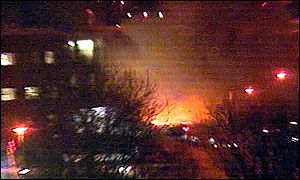
Blast outside BBC TV Centre was heard miles away
Police say a bomb which exploded outside the BBC's main news centre in London was the work of an Irish dissident group.
Alan Fry, head of Scotland Yard's Anti-Terrorist Branch, said the blast went off as bomb squad officers were trying to carry out a controlled explosion of the suspicious vehicle at 0030GMT on Sunday.
It was "clearly a big device", which contained high explosives.
He said police had received a coded warning shortly beforehand, prompting them and the BBC to evacuate the premises. One London Underground worker suffered deep cuts to his eye from flying glass.
BBC cameraman Jon Brotherton said this was the first time he had seen a bomb detonate.
"There was a huge orange fireball and a pall of smoke which, even in the night sky, was visible."
His colleague Andrew Clark was inside the BBC building when the blast happened: "The room shook. There was a loud banging. There was some panic.
A BBC spokesman said: "We evacuated the main building and put our emergency plans into action. Broadcasting on channels has remained throughout the incident."
The bomb exploded just yards from the main front door of BBC Television Centre, leaving sections of the building's metal facade hanging down.
Deputy Assistant Commissioner Fry said he believed dissident Irish Republican group, the Real IRA, were responsible for the attack.
The warning was received by a London hospital and an unnamed charitable trust at around 2320GMT on Saturday.
His colleague Andrew Clark was inside the BBC building when the blast happened: "The room shook. There was a loud banging. There was some panic
Glass shattered
Numerous windows were smashed in the front entrance and both the BBC sign and part of the Television Centre sign were missing.
One nearby resident reported hearing several loud bangs, one of which blew a glass lampshade off his living room wall.
Robert Fulton said: "The sky was lit up like fireworks and there were several loud bangs."
Scene of the bomb at BBC's TV Centre in west London
Wood Lane was cordoned off
He added that he had felt the force of the blast at his home in Uxbridge Road, which is about a quarter of a mile from the scene of the explosion.
Underground services have been severely disrupted.
The Central and Metropolitan and City Underground lines were likely to be closed in the area, a police spokesman added.
https://en.m.wikipedia.org/wiki/2001_BBC_bombing
The BBC bombing :
BBC bombing: A massive car bomb explodes in front of the BBC Television Centre in London, seriously injuring one person; the attack was attributed to the Real IRA.

Blast outside BBC TV Centre was heard miles away
Police say a bomb which exploded outside the BBC's main news centre in London was the work of an Irish dissident group.
Alan Fry, head of Scotland Yard's Anti-Terrorist Branch, said the blast went off as bomb squad officers were trying to carry out a controlled explosion of the suspicious vehicle at 0030GMT on Sunday.
It was "clearly a big device", which contained high explosives.
He said police had received a coded warning shortly beforehand, prompting them and the BBC to evacuate the premises. One London Underground worker suffered deep cuts to his eye from flying glass.
BBC cameraman Jon Brotherton said this was the first time he had seen a bomb detonate.
"There was a huge orange fireball and a pall of smoke which, even in the night sky, was visible."
His colleague Andrew Clark was inside the BBC building when the blast happened: "The room shook. There was a loud banging. There was some panic.
A BBC spokesman said: "We evacuated the main building and put our emergency plans into action. Broadcasting on channels has remained throughout the incident."
The bomb exploded just yards from the main front door of BBC Television Centre, leaving sections of the building's metal facade hanging down.
 I can only fear that we will see more attacks  |
| Scotland Yard |
The warning was received by a London hospital and an unnamed charitable trust at around 2320GMT on Saturday.
His colleague Andrew Clark was inside the BBC building when the blast happened: "The room shook. There was a loud banging. There was some panic
Glass shattered
Numerous windows were smashed in the front entrance and both the BBC sign and part of the Television Centre sign were missing.
One nearby resident reported hearing several loud bangs, one of which blew a glass lampshade off his living room wall.
Robert Fulton said: "The sky was lit up like fireworks and there were several loud bangs."
Scene of the bomb at BBC's TV Centre in west London
Wood Lane was cordoned off
He added that he had felt the force of the blast at his home in Uxbridge Road, which is about a quarter of a mile from the scene of the explosion.
Underground services have been severely disrupted.
The Central and Metropolitan and City Underground lines were likely to be closed in the area, a police spokesman added.
https://en.m.wikipedia.org/wiki/2001_BBC_bombing

gassey- BronzeProudly made in Wigan bronze award
- Posts : 4669
Join date : 2019-08-21
Age : 71
Location : Pemberton
 Re: Today in history
Re: Today in history
5 th 1963
Country music's darkest day :
American country music stars Patsy Cline, Hawkshaw Hawkins, Cowboy Copas and their pilot Randy Hughes are killed in a plane crash in Camden, Tennessee.
9ksize=15] [/size] On March 5, 1963, at 30 years of age, country singer Virginia Patterson Hensley. better known as Patsy Cline, along with her manager. Randy Hughes, and fellow Grand Ole Opry stars, Hawkshaw Hawkins and Cowboy Copas, were killed in a plane crash in Camden, Tennessee, on their way home from a benefit concert in Kansas City, Missouri. Known for her smooth-sounding emotive voice, Cline helped break down the gender barrier in the musical genre. Considered one of country music's greatest vocalists, Cline was posthumously inducted into the Country Music Hall of Fame in 1973.
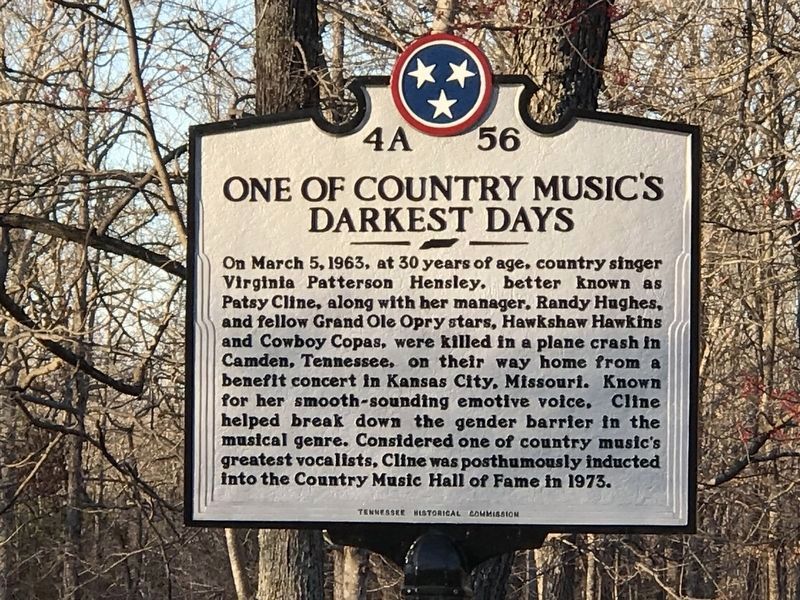
Patsy Cline died in a horrific plane crash on March 5th, 1963. Also aboard the aircraft were Cowboy Copas and Hawkshaw Hawkins. The aircraft came down in Camden, Tennessee, along with their pilot and Patsy’s manager, Randy Hughes. Patsy was just 30 years old.
Eerily enough, when it was suggested that Patsy take a six-hour drive instead of fly due to foggy weather conditions, Patsy replies, “Don’t worry about me. When it’s my time to go, it’s my time.” The plane would stop once in Missouri to refuel and then land at Dyersburg Municipal Airport in Dyersburg, Tennessee at 5 p.m. The Dyersburg, Tennessee, airfield manager would then also suggest that the crew spent the night at the airport due to high winds and severe weather.

[center][size=15]Scene of the plane crash /
https://en.m.wikipedia.org/wiki/1963_Camden_PA-24_crash
Country music's darkest day :
American country music stars Patsy Cline, Hawkshaw Hawkins, Cowboy Copas and their pilot Randy Hughes are killed in a plane crash in Camden, Tennessee.
9ksize=15] [/size] On March 5, 1963, at 30 years of age, country singer Virginia Patterson Hensley. better known as Patsy Cline, along with her manager. Randy Hughes, and fellow Grand Ole Opry stars, Hawkshaw Hawkins and Cowboy Copas, were killed in a plane crash in Camden, Tennessee, on their way home from a benefit concert in Kansas City, Missouri. Known for her smooth-sounding emotive voice, Cline helped break down the gender barrier in the musical genre. Considered one of country music's greatest vocalists, Cline was posthumously inducted into the Country Music Hall of Fame in 1973.

1. One of Country Music's Darkest Days Marker
Patsy Cline died in a horrific plane crash on March 5th, 1963. Also aboard the aircraft were Cowboy Copas and Hawkshaw Hawkins. The aircraft came down in Camden, Tennessee, along with their pilot and Patsy’s manager, Randy Hughes. Patsy was just 30 years old.
Eerily enough, when it was suggested that Patsy take a six-hour drive instead of fly due to foggy weather conditions, Patsy replies, “Don’t worry about me. When it’s my time to go, it’s my time.” The plane would stop once in Missouri to refuel and then land at Dyersburg Municipal Airport in Dyersburg, Tennessee at 5 p.m. The Dyersburg, Tennessee, airfield manager would then also suggest that the crew spent the night at the airport due to high winds and severe weather.

[center][size=15]Scene of the plane crash /
https://en.m.wikipedia.org/wiki/1963_Camden_PA-24_crash

gassey- BronzeProudly made in Wigan bronze award
- Posts : 4669
Join date : 2019-08-21
Age : 71
Location : Pemberton
Page 24 of 40 •  1 ... 13 ... 23, 24, 25 ... 32 ... 40
1 ... 13 ... 23, 24, 25 ... 32 ... 40 
Page 24 of 40
Permissions in this forum:
You cannot reply to topics in this forum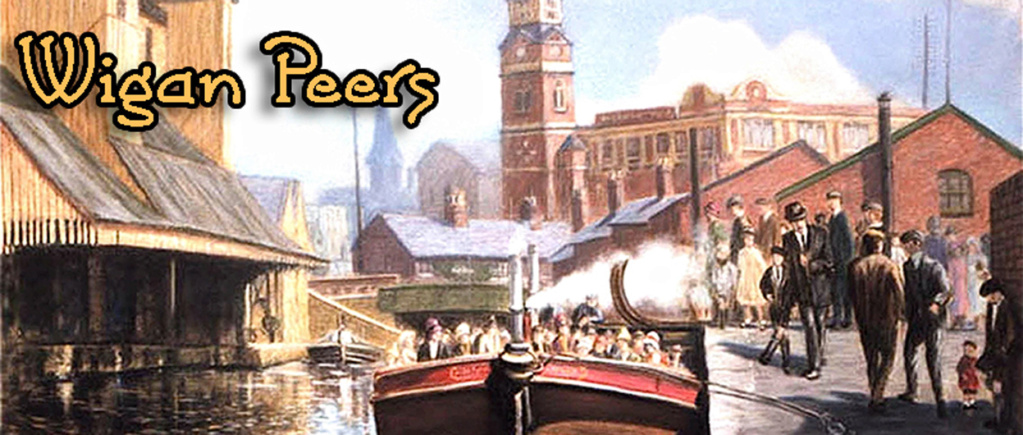
 Home
Home